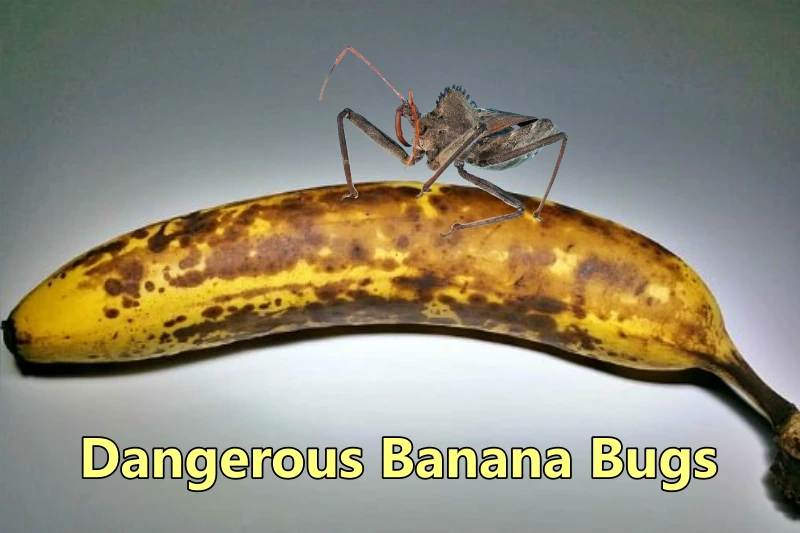Bananas are one of the most consumed fruits globally, and they also attract a diverse range of insects. While some of these bugs pose no threat, others can significantly harm banana plants and fruits.
In this blog post, we will delve into the perilous bugs found in bananas as well as discuss effective methods for prevention and control.
Here’s a comprehensive list of 56 dangerous bugs that affect bananas.
56 Dangerous Banana Bugs found in nature
1. Psuedostem weevil (Odioporus longicollis)

The Psuedostem weevil (Odioporus longicollis) is the first pest species we have identified for bananas. The adults range in body length from 23 to 39 cm and are black.
One of the most destructive pests of bananas and plantains is this one. These beetles have a year-long lifespan.
These nocturnal monophagous species are active throughout the daytime during the rainy seasons.
2. Corm weevil (Cosmopolites sordidus)

As the name suggests, these bugs can be found anywhere bananas are grown, including southern Asia, Africa, Macaronesia, Australia, South and Central America, the West Indies, and Mexico.
They are distinctive due to their 11mm size and shiny black exterior. The East African highland bananas and plantains are what these banana root borers most frequently target.
3. Small banana weevil (Polytus mellerborgii)
In the Indo-Malayan region, these tiny beetles pose a serious threat to banana crops.
They are frequently confused for Cosmopolites sordidus due to their look. ‘
The majority of the time, they are discovered in the decomposing trunks and bores of banana corms and stalks.
4. Banana fruit and leaf scarring beetles (Basilepta spp.)

In Bangladesh and northern and northeastern India, fruit and leaf scarring beetles (Basilepta spp.) are significant pests that reduce the market value and aesthetic appeal of fruits.
The young unfolded leaves, stems, and roots of banana trees are among the weeds that the adult beetles consume in addition to these items.
5. Banana lacewing bug (Stephanitis typica)

These are the next pest in our list. In India, Sri Lanka, Southeast Asia, and the tropical West Pacific, these bugs are extremely prevalent.
They mostly feed on the side of the midrib, which causes chlorotic patches to appear on the surface of the leaf and gives them a stippling pattern.
During the summer, they are known to cause more damage.
6. Banana flower thrips (Thrips hawaiiensis)
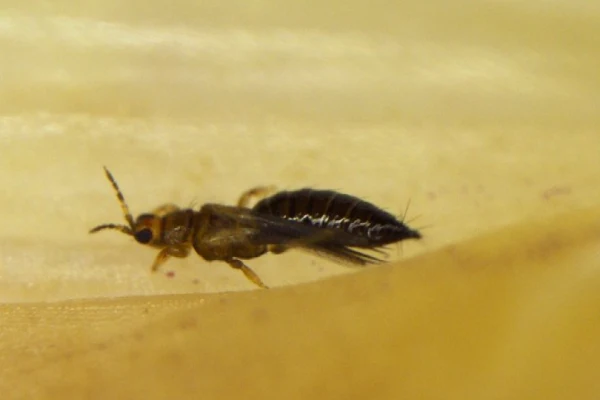
Flower thrips assail the flowers, and immature and damaged fruits are scarred and have a lower market value.
Brown in color, this species features an orange-yellow head and thorax.
They are found in Asia, the Pacific, the southern states of the United States, and Jamaica.
7. Banana leaf thrips (Helionothrips kadaliphilus)
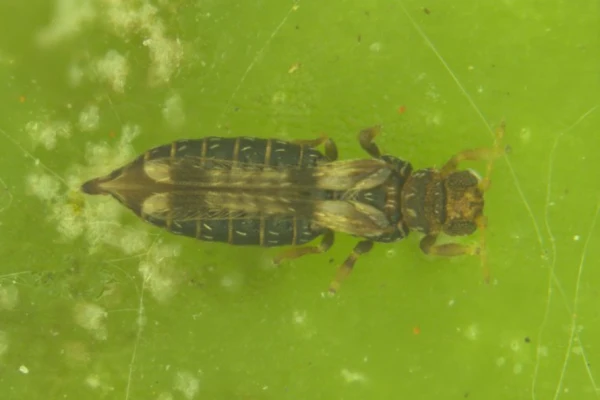
Their name makes it very evident that they infest the underside of leaves, giving them a blighted appearance and a yellowing.
They are common in many tropical and subtropical regions, including West Bengal, Kerala, Manipur, Meghalaya, Tamil Nadu, and Maharashtra.
The leaves have silvery white patches due to the adult thrips, which are dark reddish brown in hue.
8. Banana silvering thrips (Hercinothrips bicinctus)
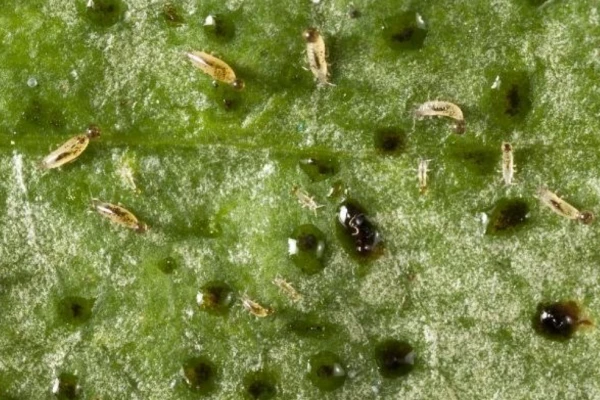
Silver speckling in green fruit, particularly bananas, is known to be caused by these thrips.
They more closely resemble the banana leaf thrips (Helionothrips kadaliphilus) in appearance.
This species, which originated in Africa and is now widespread over the globe, is also a pest of other crops, such as African nightshade, eggplant, and potato.
9. Asprothrips navsariensis
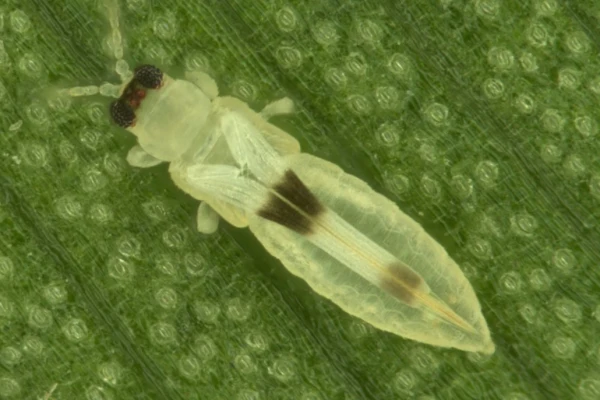
This banana pest species is reported in Gujrat, India, and Bogor, Indonesia.
Their body is white in color, and their mesothoracic furca is enlarged, y-shaped, and extended until the mesothorax.
These are the smallest thrips, and in this species, they mostly prefer the top three leaves, which is why older leaves are not affected.
10. Banana aphid (Pentalonia nigronervosa)
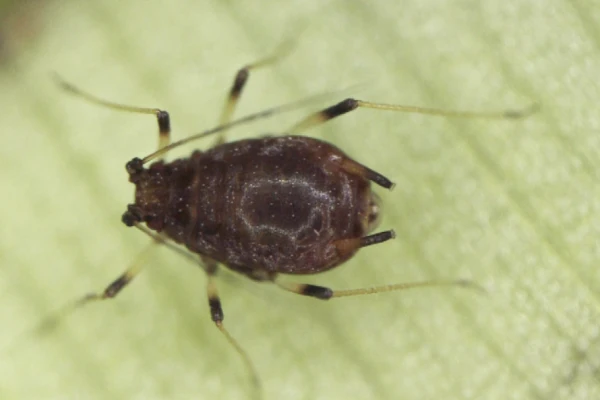
These aphid species mostly prefer bananas, as their common name indicates.
They are phloem feeders and use their stylets to drink sap directly from vessels.
They are serious threats to bananas because they transmit a lot of diseases, like dark green streaking of the leaves, midrib, and petioles.
11. Banana Scale (Aspidiotus destructor)
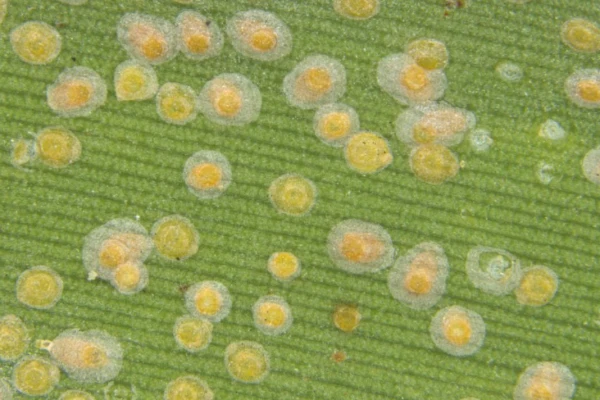
This major coconut pest is also known to affect bananas. The insect causes yellowing, tissue distortion, and death by consuming plant sap from leaves, stems, and fruits.
This tropical and subtropical-inhabited species protect themselves in waxy covers.
12. Oriental yellow scale (Aonidiella orientalis)
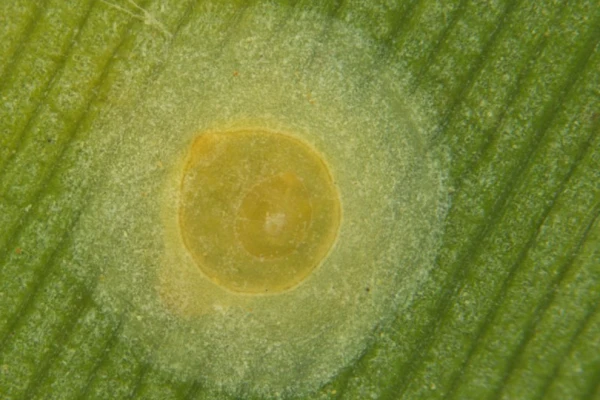
Aonidiella orientalis is the major pest of bananas and belongs to the family Diaspididae.
The females of this species are flat and circular and covered with a shield of wax. They cause the damage by sucking sap and cause discoloration and deformation of leaves.
Flowers and fruits fail to develop. It reduced their market value.
13. Hemiberlesia spp.
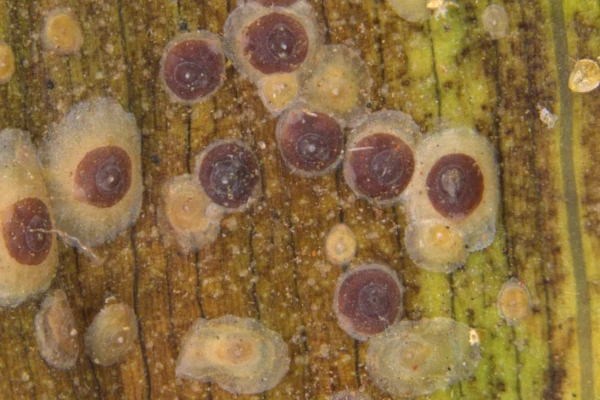
They are a group of scale insects that are circular, flat, and covered by a transparent cover.
They feed on the saps and cause damage to the leaves, stems, and fruits.
Yellowing, curling, or dropping of leaves, twig dieback, or fruit blemishes are some effects caused by them.
14. Lindingaspis misrae
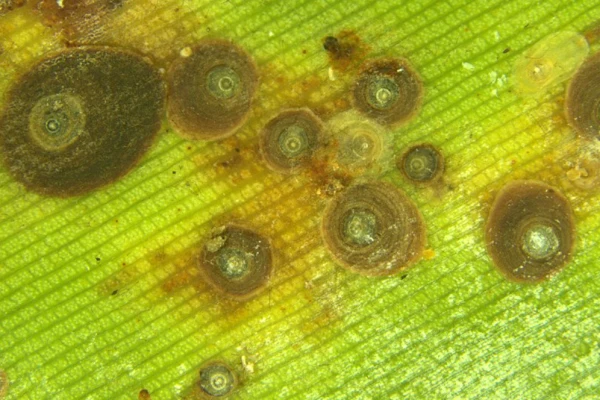
It has a circular, brownish-red scale cover with a central nipple and a marginal rim.
These polyphagous insects caused a lot of damage to banana plants, like stunting, yellowing, and leaf drop, by sucking their sap.
They are most commonly seen in Tamil Nadu in dry environments.
15. Oyster scale (Pseudaulacaspis cockerelli)
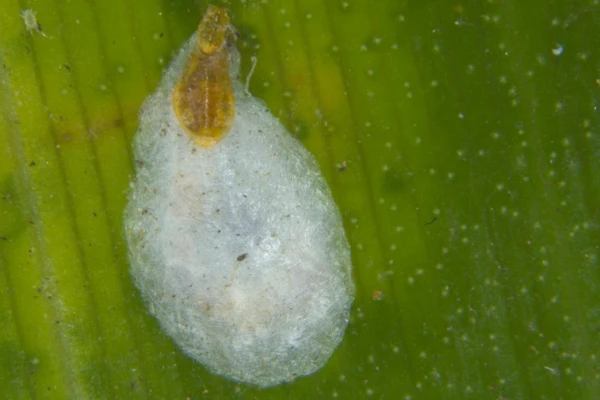
Pseudaulacaspis cockerelli is a native invasive species from Southern Asia that has been introduced into the United States. ‘
Their name indicates that it has a grayish-brown waxy cover that resembles a miniature oyster.
It feeds on the sap of the plant cells under the bark, causing yellowing, wilting, and dieback of the affected branches. It can also weaken the plant and make it more susceptible to diseases and other pests.
16. Root mealybug (Geococcus spp.)
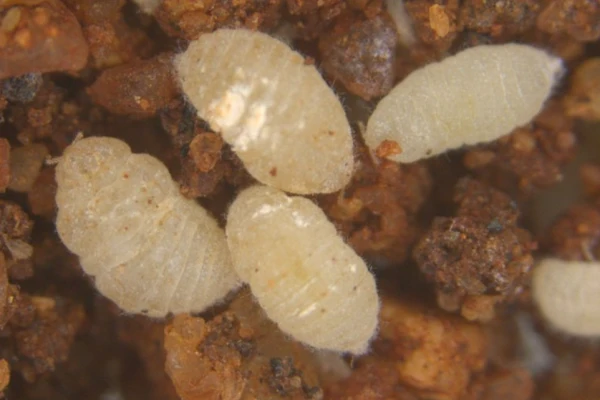
Geococcus spp. are a group of scale insects that infest the roots of banana plants and cause damage to the crop.
They feed on the sap of the roots and affect the plant’s yield and quality.
They are typically oval-shaped and white in color, with sucking mouthparts.
17. Rhizoecus sp.
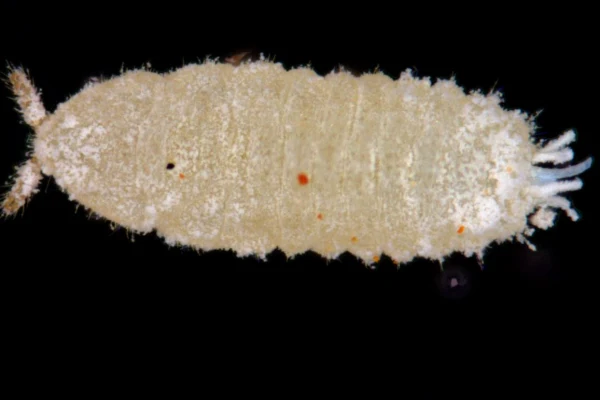
This genus of root mealybugs is commonly seen feeding on banana roots.
By appearance, they are similar to Geococcus spp. but do not cause much damage like them.
Rhizoecus sp. is difficult to control because it is hidden in the soil and has a waxy coating that protects it from insecticides.
18. Solenopsis mealybug (Phenacoccus solenopsis)
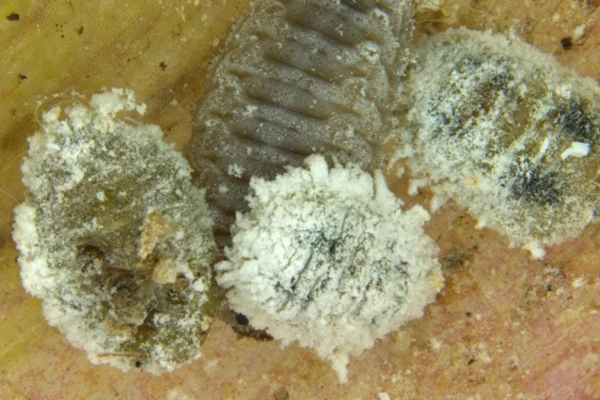
Phenacoccus solenopsis is commonly known as the Solenopsis mealybug or cotton mealybug.
This North American native is ellipsoidal in shape and has a size of up to 5 mm.
The infestation of this species causes stunting of plants, yellowing, distortion, premature shedding of leaves, and reduced photosynthesis.
19. Tailed mealybug (Ferrisia virgata)

The striped mealybug is named for the two dark, dorsal stripes that run longitudinally down its body and two waxy tails at its posterior ends.
Like any other mealybug, they also secrete honeydew to attract fungi, which forms a dark film over the leaf surface and impairs photosynthesis.
Leaf discoloration and leaf and fruit drops are also symptoms of mealybug infestations.
20. Pink hibiscus mealybug (Maconellicoccus hirsutus)

As their name suggests, these hibiscus mealybugs are pink in color with a white waxy covering.
During feeding, they inject their saliva into their host, which causes malformed leaves, shoot growth, stunting, and occasional death.
This bug is found all around the globe, including Asia, the Middle East, Africa, Australia, and Oceania.
21. Jack Beardsly mealybug (Pseudococcus jackbeardsleyi)
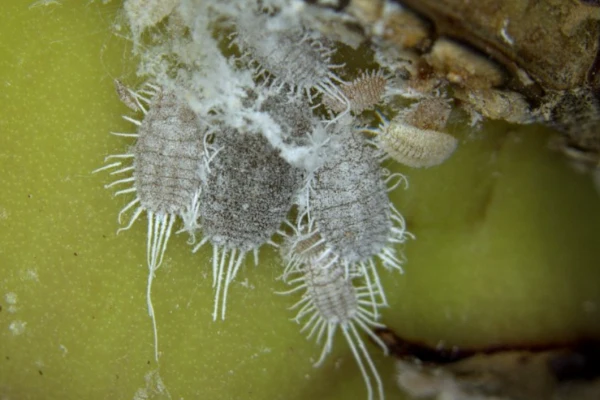
The Neotropical region is home to the mealybug species Pseudococcus jackbeardsleyi, which has spread throughout the world as an invasive pest.
With a short tail, a powdery white covering, and a pinkish or yellowish body hue, it has a striking appearance.
22. Fruit mealybug (Rastrococcus iceryoides)
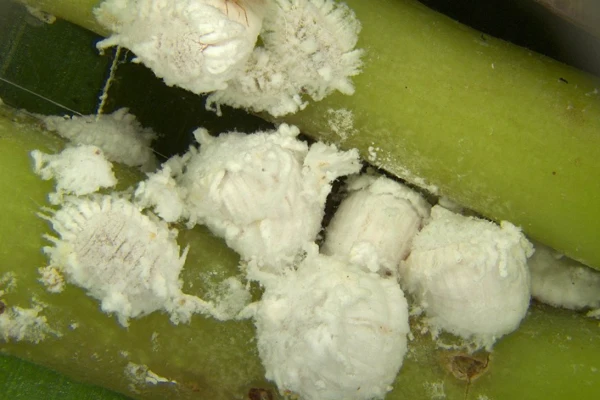
Citrus mealybug or fruit mealybug are the common names of Rastrococcus iceryoides.
These small insects are covered with a white waxy substance, which gives them a mealy appearance.
It is considered one of the major pests of bananas. These are mostly active during the summer season, reduce fruit production, and cause leaf drops.
23. Pink pineapple mealybug (Dysmicoccus brevipes)
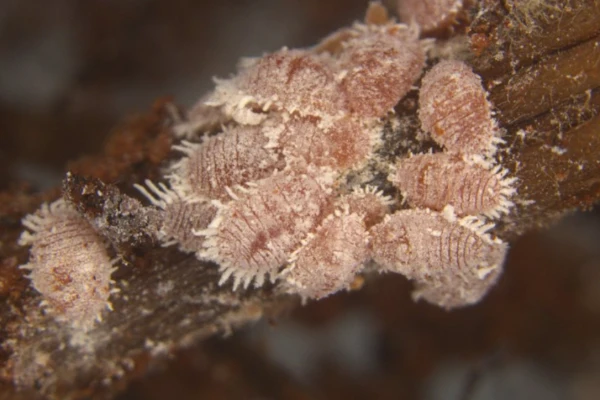
Dysmicoccus brevipes is round to oval-shaped and can attain a size of up to 2.3 to 3.0 mm.
They are a very common pest on bananas and pineapples. wax-producing glands, which produce short wax filaments that conceal the body.
24. Grey pineapple mealybug (Dysmicoccus neobrevipes)
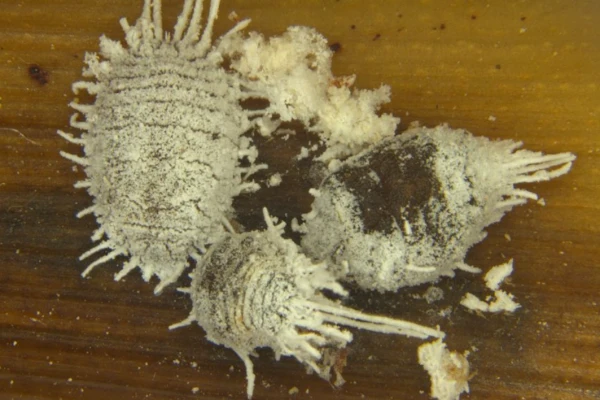
It is also called the gray pineapple mealybug because it is a major pineapple pest and has a grayish body color.
They have long, waxy filaments that form a plate-like fringe.
It is known to cause damage to plant tissues, reduce quality and yield, and transmit plant diseases.
25. Black scale (Saissetia nigra)
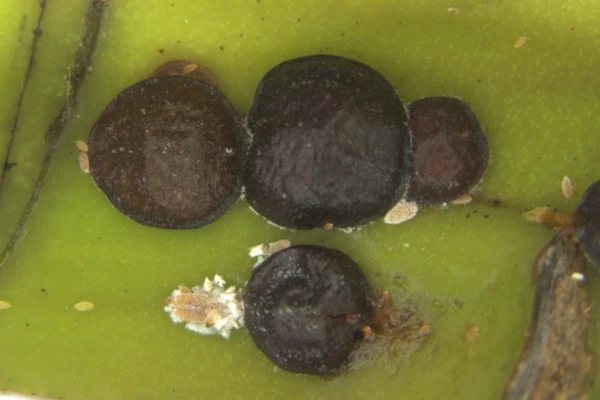
Females of these species are elliptical, flattened, and shiny black in color, and are covered by hard shells.
They mainly affect tender leaves, shoots, and twigs.
Due to honeydew production, sooty mold fungus is seen on leaves.
26. Nigra Scale (Parasaissetia nigra)
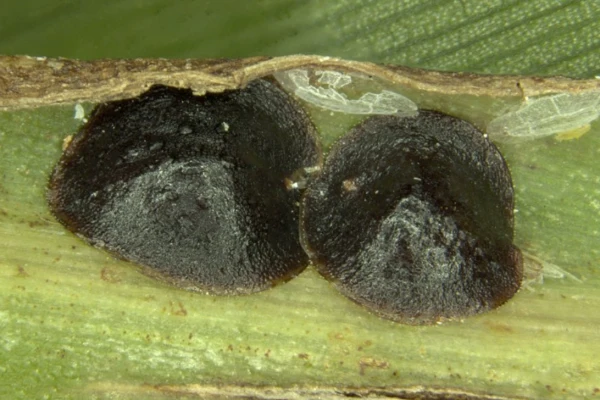
Parasaissetta nigra is a member of the scale insect group, which is parthenogenetic and polyphagous and feeds on a large variety of plant species.
This African native species has a cosmopolitan distribution. It infests both leaves and fruits.
27. Coccus hesperidum
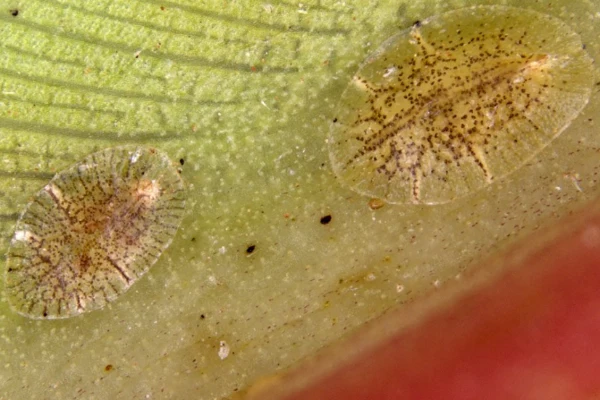
It is commonly known as brown soft scale. This polyphagous species is found all across the world.
It is yellowish brown in color with brown irregular speckles.
They affect the market value of the bananas by ruining their appearance, as they lead to the accumulation of sooty mold fungus.
28. Wax scale (Ceroplastes sp.)

Wax scales are a group of insects that secrete waxy substances that cover their bodies and protect them from threats.
You can easily find them on banana farms, but they are not harmful to bananas.
They damage the plant by secreting honeydew or feeding on sap.
29. Banana whitefly (Aleurolobus musae)
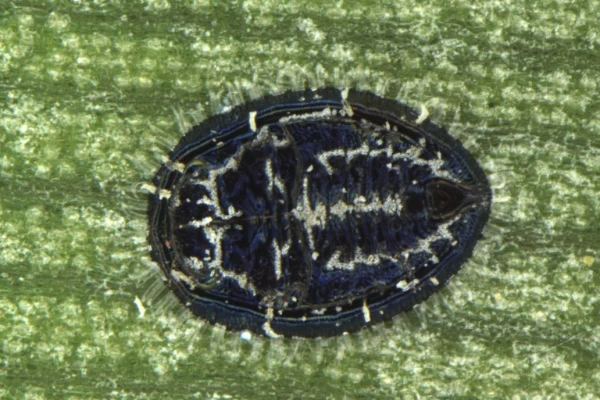
It is known as the banana whitefly as it is the pest of bananas and affects both leaves and fruits.
One can easily find them in India, Indonesia, Malaysia, Sri Lanka, Thailand, and Vietnam.
Apart from damage, they also transmit viruses such as the banana bunchy top virus and the banana streak virus.
30. Spiraling whitefly (Aleurodicus dispersus)
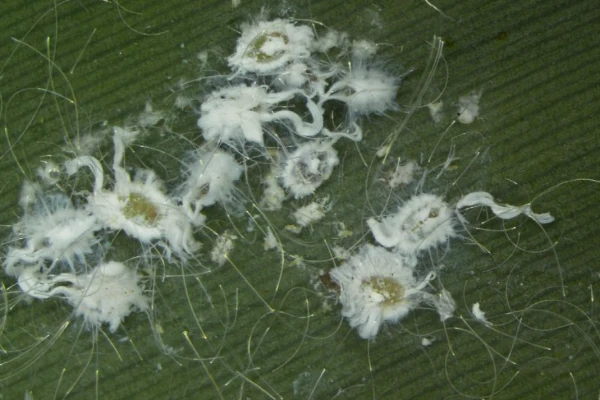
Aleurodicus dispersus is commonly known as a spiraling whitefly because it lays its eggs in a spiral pattern on the underside of the leaves.
They are flat, oval, and pale yellow in color and can grow up to 4 mm.
This central American-origin species is now found worldwide and is considered a major agricultural pest that mostly infests bananas.
31. Rugose spiraling whitefly (Aleurodicus rugioperculatus)
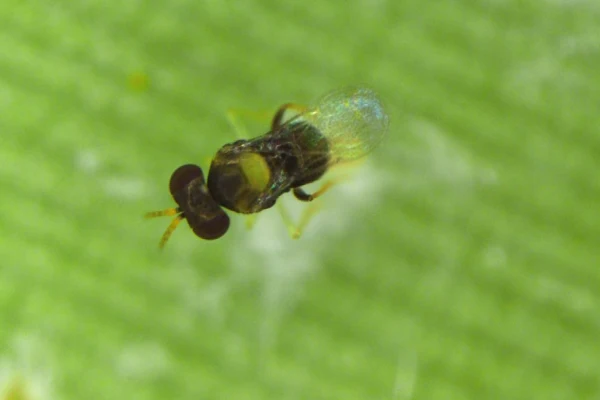
According to ICAR, they are the newly introduced invasive pest species in South India.
They feed on a variety of crop species, but bananas and coconut are the most preferred ones.
This whitefly is medium-sized and has two irregular brown bands across the wings.
32. Aleurocanthus sp.
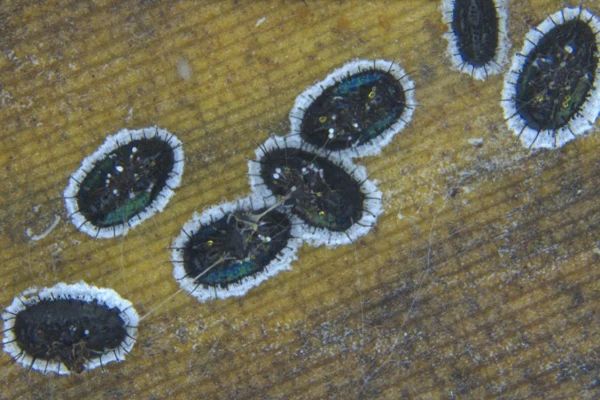
It is a genus of white flies that is widely distributed all across the world.
They are polyphagous and feed on a lot of plant species, but citrus and bananas are the most common.
The image shows that they have a black body with white margins, which makes them distinct.
33. Banana mirid bug (Prodromus clypeatus)

Prodromus clypeatus, commonly known as the banana mirid bug, belongs to the family Miridae.
They are pale yellow with a brown scutellum and two distinctive brown eyes.
This South Indian endemic species feeds on bananas and causes damage to them.
34. Leaf caterpillar (Sodoptera litura)
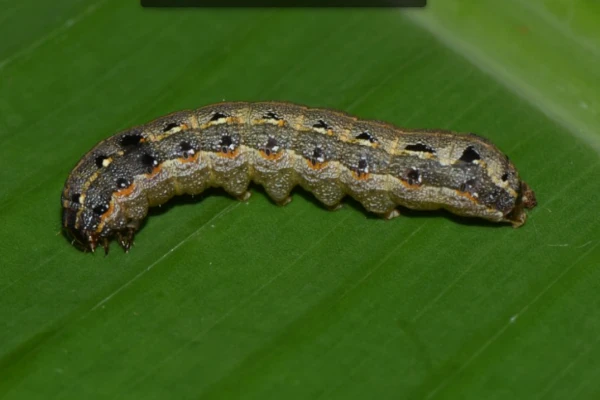
Sodoptera litura is a serious pest in the Indian subcontinent and causes significant damage to banana species.
The caterpillar of this species is pale brown in color with yellow stripes and dark markings.
They have the ability to adapt to different environments and host plants.
35. Fall armyworm (Spodoptera frugiperda)
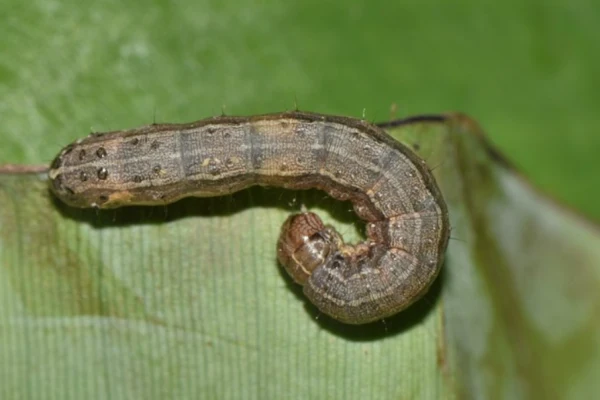
Spodoptera frugiperda is a species of moth that is a major pest species in many parts of the world and infests a variety of plants, including bananas.
Their larvae are greenish-brown in color with pale white stripes and dark spots.
They are present in large numbers, feed on foliage, and significantly degrade the crop.
36. Banana skipper (Erionota torus)

The rounded palm-redeye, Sikkim palm dart, Sikkim palm-red-eye, and banana skipper are some of the common names of this butterfly species.
The larvae of this species are covered with white, waxy powder and have a dark black head.
These larvae caused significant damage to bananas in peninsular India.
37. Banana bagworm (Kophene cuprea)
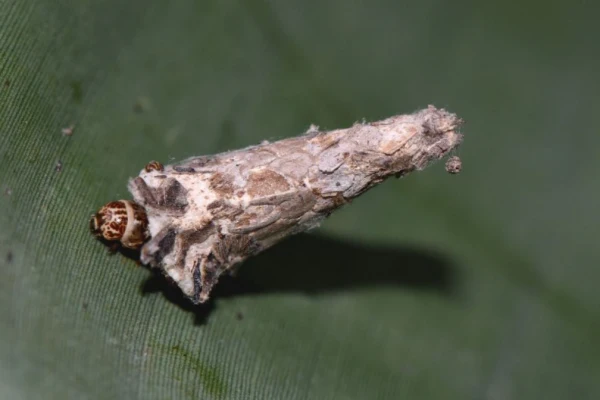
Kophene cuprea is commonly known as banana bagworm and is found in South and Southeast Asia.
The larvae of this moth species are covered in a bag-like structure that they made from plant material and their own silk.
They usually feed on the banana leaves and cause severe damage to them.
38. Hairy caterpillar (Olepa ricini)

It is commonly found in Bangladesh, India, Nepal, and Sri Lanka.
As you can see in the picture, larvae are dark brown with dorsal and lateral tufts of dark hairs, which is why they get their name.
They feed on a variety of plants, primarily banana foliage.
39. Olene mendosa

The caterpillar of this species is polyphagous and feeds on a diverse range of plants, including banana foliage.
These caterpillars are hairy grayish brown in color with four white tussocks.
It is found in India, Bangladesh, Sri Lanka, Indonesia, Taiwan, Thailand, and Australia.
40. Somena scintillans
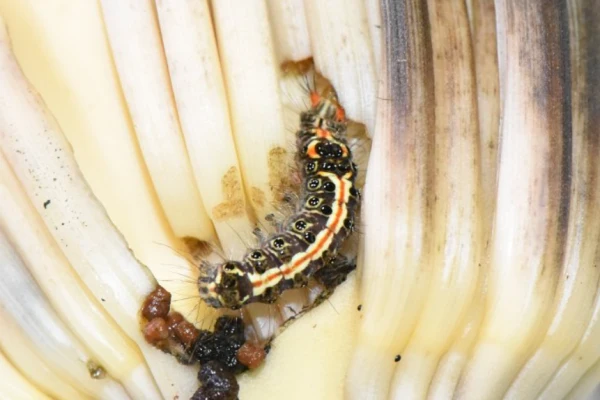
The caterpillar of Somena scintillans is commonly found in northern India, Sri Lanka, Myanmar, and the Andaman Islands.
The caterpillar is dark brown in color with a yellow middle line carrying tufts of gray hair and a crimson lateral tubercle on it.
They are a very big problem for the farmers economically, and they usually feed on banana fruits and foliage.
41. Euproctis fraterna

This larva, also known as a hairy caterpillar, is yellowish with a brown head, has a yellowish stripe with a central red line, and has hairs on its lateral sides.
Euproctis fraterna is commonly found in India, the Maldives, Sri Lanka, and the Seychelles.
Like other hairy caterpillars, they mainly feed on banana fruit and foliage. Defoliation is the first sign of their attack.
42. Amata passalis
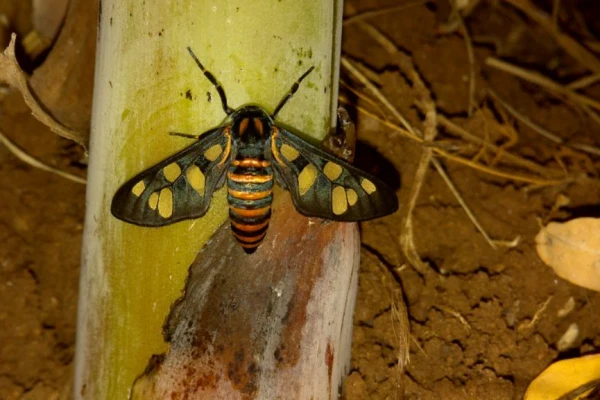
The sandalwood defoliator is the common name of Amata passalis, which is commonly found in Sri Lanka and India.
They are multivoltage, which means they produce 6 to 11 generations per year.
They have alternate yellow and black bands on their bodies, and their black wings have yellow patches. It causes the skeletonization and drying of leaves.
43. Chrysodeixis chalcites

The golden twin spot moth or tomato looper are the common names of Chrysodeixis chalcites,which belong to the family Noctuidae.
These mature larvae are pale yellow-green with a glassy-green to grey head with a black streak.
They are polyphagous and feed on many fruits, vegetables, and ornamental crops. Banana leaf skeletonization and rolling are caused by these organisms.
44. Banana Slug Caterpillar (Miersa decedens)
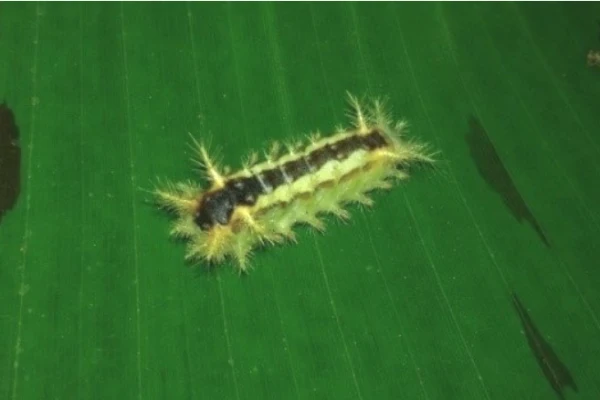
This Indian endemic species is a serious pest of banana plants.
As their name suggests, these caterpillars have a slug-like appearance and are usually green or brown in color with distinctive yellow appendages.
They cause the same damage as the other lepidopteran pests.
45. Slug caterpillars (Spatulifimbria spp.)

Spatulifimbria spp. is a genus of insects that belong to the family Limacodinae, also known as slug caterpillars.
They are named so because of their flattened and spatulate body shape, which helps them hide themselves from their host plants.
They occasionally feed on the leaves of banana plants and cause defoliation.
46. Fruit Flies
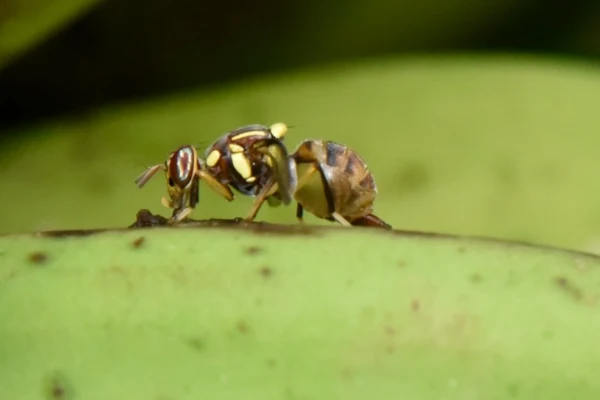
The next banana pest we have on our list is fruit flies. Wild-type Drosophila melanogaster is yellow-brown with red eyes and has transverse black bands all over the abdomen.
They exhibit sexual dimorphism; males are slightly smaller than females.
It mainly infests bananas that are ripe or overripe and lays eggs on them, contaminating them with bacteria and making them rot faster.
47. Fruit Spotting bug (Physomerus grossipes)
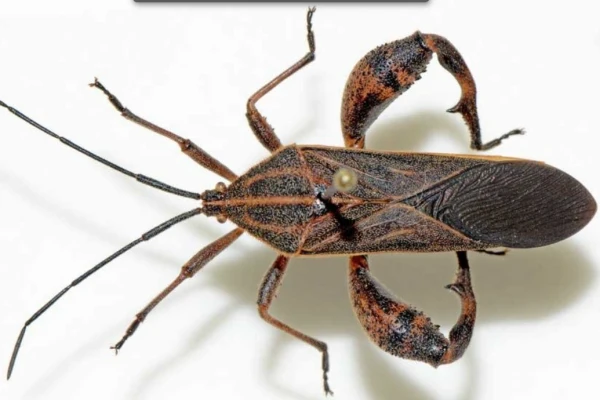
The next bug we have on our list is the fruit spotting bug. These Southeastern Asian native species are also found in the Pacific Islands.
They are brown in color with black legs, have segmented antennae, and can attain a size of up to 2 m.
They are the best-known example of maternal care in a large family. These gregarious beetles are the sporadic pests of banana fruit.
48. Spider mite (Oligochynus indicus)
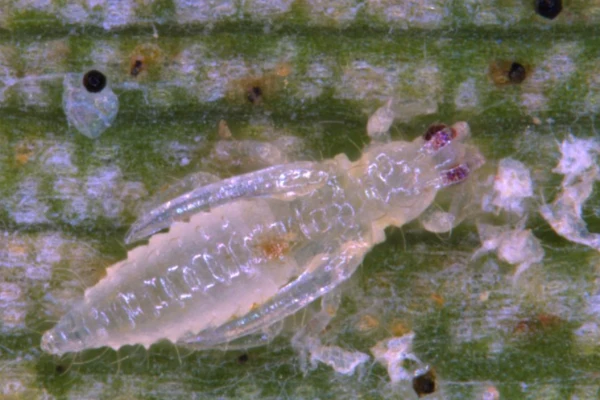
The sugarcane red spider mite or sugarcane leaf mite is the major pest of sugarcane, maize, banana, sorghum, and other crops. They are pale white in color with remarkable bright red eyes.
They feed on the sap of plants which causes yellowing and browning of leaves, stippling and mottling of leaves, weakened plants, and reduced yields.
The mites live on the underside of leaves, where they spin a delicate web of silk.
49. Red spider mites (Tetranychus spp.)
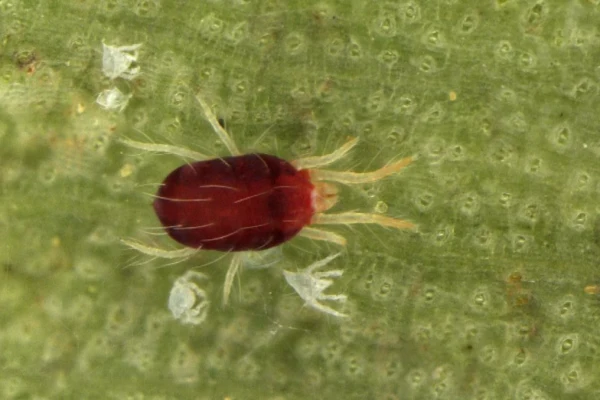
The Red spider mites are very small, barely visible to the naked eye, and have various colors depending on the species and the season.
These polyphagous, cosmopolitan species are responsible for significant damage, and infestations on ornamental and vegetable crops.
They can also spin fine webs on and under the leaves to protect themselves from predators and environmental factors.
This banana foliage pest species is very common in summer.
50. Oriental red mite (Eutetranychus orientalis)
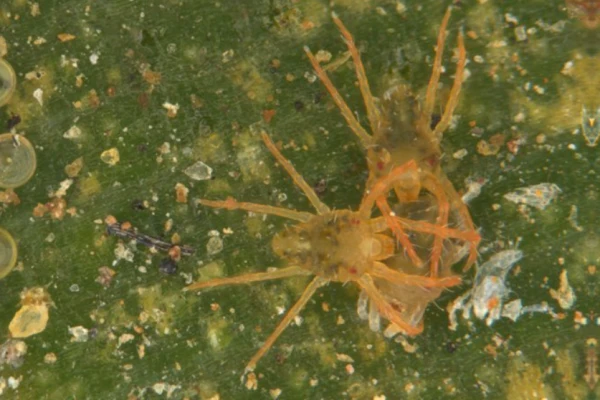
The oriental spider mite occurs in countries, like Asia, from India to China, and in most of Africa.
Females have an oval brownish body with an average length of 0.4 to 0.5 mm, whereas males are red in color and their legs are longer than the body.
They are serious pests on banana and citrus plants. One can find them feeding banana foliage during the summer.
51. Raoiella indica
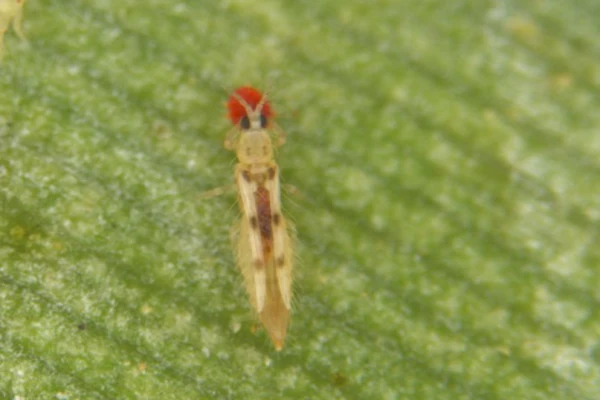
The red palm mite, or Raoiella indica, is a mite species belonging to the family Tenuipalpidae. It is a pest of many palm and banana plants and has invaded the Western Hemisphere in recent years.
This species is native to Egypt, India, Iran, Israel, Mauritius, Oman, Pakistan, the Philippines, Réunion, Saudi Arabia, Sri Lanka, Sudan, Thailand, and the United Arab Emirates.
They have flattened and spatulate bright red bodies. This mite species causes great havoc during the summer.
52. Cerambycid beetle (Sybra praeusta)
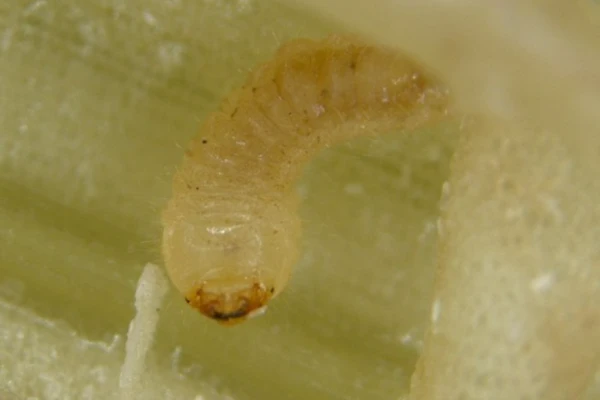
It is also known as the long-horn beetle. This beetle is found in India and Sri Lanka, and it is a minor pest of banana plants.
The larvae can reduce the plant’s vigor and cause yellowing and drying of the outer leaves.
The adults can also transmit diseases such as the banana bunchy top virus and the banana streak virus, which can affect the yield and quality of the fruit.
53. Ropica signata
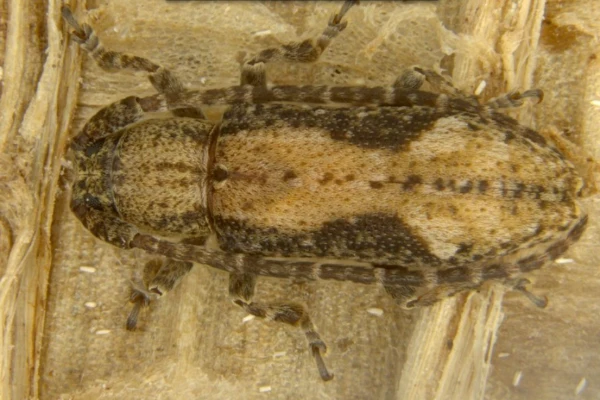
It is the type of long-horned beetle that infests bananas in India and other parts of Asia.
They are known for their unique living adaptation; they reside in between the leaf sheath and outer layer of the Psuedostem of an old banana.
Let’s talk about their appearance. They have a cylindrical black body with yellow markings.
They are known to be active during the summer and mostly feed on old and decaying bananas.
54. Cercopid (Phymatostetha deschampsi)
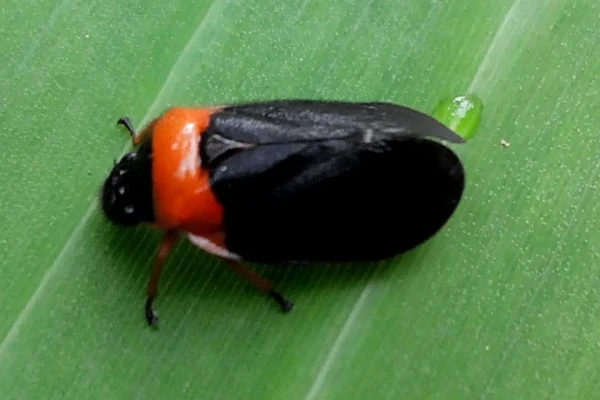
Phymatostetha deschampsi is a species of froghopper in the family Cercopidae. This banana pest species is commonly found in Kerala and other parts of South India.
It is jet black in color with brownish appendages and a red band on its thorax. This sucking pest mostly feeds on banana leaves and foliage.
The nymphs of this species produce a foam that protects and hides them from predators.
55. Rhinoceros beetle (Oryctes rhinoceros)
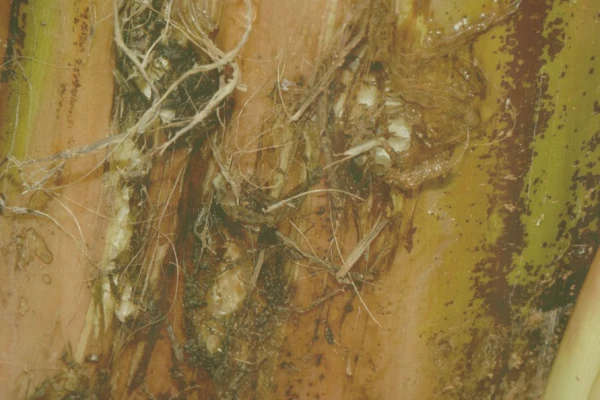
Asiatic rhinoceros beetle, coconut rhinoceros beetle, or coconut palm rhinoceros beetle are some of the common names of this beetle, Orycytes rhinoceros.
These large beetles are black to brown in color with a prominent horn on the head and have an average size of 33 to 40 mm.
Adults of this species are a significant pest of coconut and oil palms, as well as bananas and other plants. They are removed from the plants by handpicking or other mechanical methods.
56. Neothacris sp.
Neothacris sp. is a genus of wingless grasshoppers. They are found in southern Asia, mainly in India.
They have bright green bodies with black bands on the protonatum and mesothorax. It is the most common pest of banana plants that causes defoliation by feeding on them.
These voracious feeders are the most important part of banana ecosystems.
Conclusion
Bananas are important food crops that face many threats from various pests and diseases. Bugs can cause direct damage to banana plants and fruits, as well as transmit diseases that can reduce yield and quality.
Therefore, some of these bugs are more prevalent or destructive in certain regions or climates than others. It is important to monitor and manage these pests using appropriate methods such as cultural practices, biological control, chemical control, or resistant varieties.
By doing so, banana growers can protect their crops and ensure food security and income. I hope you like this article. We will be back with another article soon.
Sources and Credits
All images in this article are courtesy of https://nrcb.icar.gov.in/album/
References:
- https://nrcb.icar.gov.in/album/
- Wikipedia
Also Read:

Being a zoology student I’m always been fascinated toward animals especially insects. I love to do research and learn about different animals. As a writer I want to share my thoughts about nature through my articles. Apart from this you can find me exploring the new places and voice notes.
